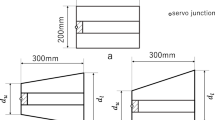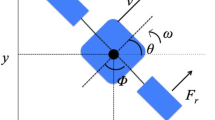Abstract
Recently, biomimetic robots combining the characteristics of fish robots and airship robots have been studied. In this work, we consider balloon fish robots (BFR). This paper presents our understanding of the BFR motion obtained through simulations and experimental results. The simulation of the BFR motion is based on a traveling-wave equation, defined as the product of a sine wave and quadratic curve. In this study, we derived an equation of motion for BFR and conducted an experiment to measure the thrust force. By solving the equation of motion with the Runge–Kutta method, we are able to calculate theoretical values for the propulsion velocity of BFR. We validate the simulation by comparing theoretical and experimental propulsion speed values. As a future task, we will measure BFR thrust at more parameters.










Similar content being viewed by others
References
Hosoi K, Sugimoto M (2004) An autonomous security system using multi-flying robots. In: The 18th annual conference of the Japanese Society for Artificial Intelligence, 2C1-04
Zhang H, Ostrowski JP (1999) Visual servoing with dynamics: control of unmanned blimp. In: Proceedings of IEEE international conference on robotics and automation, pp 618–623
Yamada M, Taki Y, Funabashi Y (2010) Global position and attitude control of an airship system against a constant wind disturbance. Trans Jpn Soc Mech Eng C 76(767):1770–1779
Yu J, Liu L, Wang L, Tan M, Xu D (2008) Turning control of a multilink biomimetic robotic fish. IEEE Trans Robot 24(1):201–206
Lighthill MJ (1960) Note on the swimming of slender sh. J FluidMech 9:305–317
Barrett D, Grosenbaugh M, Triantafyllou M (1996) The optimal control of a exible hull robotic undersea vehicle propelled by an oscillating foil. In: Proceedings of IEEE AUV symposium, pp 1–9
Shibata T, Wada K (2012) Robot theraphy: mental health care by using animal type robot (4. application technology supporting human activities, special issue, ICT for understanding human and his/her activities: from sensing and information technology to its applications). J IEICE 95(5):442–445
Yu J, Wang L, Tan M (2007) Geometric optimization of relative link lengths for biomimetic robotic fish. IEEE Trans Robot 23(2)
Yu J, Wang L (2005) Parameter optimization of simplified propulsive model for biomimetic robot fish. In: Proceedings of the 2005 IEEE international conference on robotics and automation, ICRA 2005
Author information
Authors and Affiliations
Corresponding author
Additional information
This work was presented in part at the 21st International Symposium on Artificial Life and Robotics, Beppu, Oita, January 20–22, 2016.
About this article
Cite this article
Haga, M., Uchida, M. Propulsion modeling of caudal fin driving system on balloon fish robot. Artif Life Robotics 22, 10–16 (2017). https://doi.org/10.1007/s10015-016-0328-z
Received:
Accepted:
Published:
Issue Date:
DOI: https://doi.org/10.1007/s10015-016-0328-z




